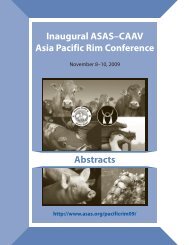PROCEEDINGS - American Society of Animal Science
PROCEEDINGS - American Society of Animal Science
PROCEEDINGS - American Society of Animal Science
You also want an ePaper? Increase the reach of your titles
YUMPU automatically turns print PDFs into web optimized ePapers that Google loves.
Proceedings, Western Section, <strong>American</strong> <strong>Society</strong> <strong>of</strong> <strong>Animal</strong> <strong>Science</strong><br />
Vol. 60, 2009<br />
RELATIONSHIPS OF EXIT VELOCITY AND AVERAGE CHUTE SCORE WITH CARCASS TRAITS IN<br />
FEEDLOT STEERS<br />
A.R. Pepper 1 , R.M. Enns 1 , R.L. Weaber 2 , H. Van Campen 3 , G.H. Loneragan 4 , J.L. Salak-Johnson 5 , C.C.L. Chase 6 ,<br />
R.K. Peel 1 , J.J. Wagner 1 , D.H. Crews, Jr. 1 , and E.J. Pollak 7<br />
1 Department <strong>of</strong> <strong>Animal</strong> <strong>Science</strong>s, Colorado State University, Fort Collins; 2 Division <strong>of</strong> <strong>Animal</strong> <strong>Science</strong>, University <strong>of</strong><br />
Missouri, Columbia; 3 Department <strong>of</strong> Microbiology, Immunology and Pathology, Colorado State University, Fort Collins;<br />
4 Department <strong>of</strong> Agricultural <strong>Science</strong>s, West Texas A&M University, Canyon; 5 Department <strong>of</strong> <strong>Animal</strong> <strong>Science</strong>s, University <strong>of</strong><br />
Illinois, Urbana; 6 Department <strong>of</strong> Biology and Microbiology, South Dakota State University, Brookings; 7 Department <strong>of</strong><br />
<strong>Animal</strong> <strong>Science</strong>s, Cornell University, Ithaca<br />
ABSRACT: The objective <strong>of</strong> this study was to estimate<br />
relationships between temperament, as measured by exit<br />
velocity and chute score, and carcass trait performance.<br />
Crossbred steers (n=1,551) from three operational units <strong>of</strong> a<br />
single ranch were transported approximately 8 hours from<br />
western Nebraska to a commercial feedlot in southeast<br />
Colorado over three days. Steers were housed overnight in<br />
receiving pens before being processed and allocated to their<br />
final pens (n=6) for the feeding period. Exit velocity and<br />
chute score were measured at receiving (EV; m/s, CS) and<br />
approximately 75 d later at re-implant (EV_RI; m/s,<br />
CS_RI). <strong>Animal</strong>s were harvested and carcass data collected<br />
after 225 d on feed. Analyses were conducted using a<br />
mixed effects model via the MIXED procedure <strong>of</strong> SAS.<br />
Analyses evaluated the associations <strong>of</strong> EV, EV_RI, CS, and<br />
CS_RI independently on hot carcass weight (HCW), fat<br />
thickness (FAT), ribeye area (REA), kidney, pelvic and<br />
heart fat (KPH), marbling score (MS), and USDA yield<br />
grade (YG). All models included the fixed effect <strong>of</strong> ranchpen<br />
class, and a random animal effect. An increase <strong>of</strong> 1m/s<br />
in EV was associated with a 2.69 kg decrease (P < 0.05) in<br />
HCW. An increase <strong>of</strong> 1 m/s in EV_RI revealed an<br />
associated decrease in HCW <strong>of</strong> 2.29 kg (P < 0.01).<br />
Similarly a one unit increase in CS was associated with a<br />
decrease in marbling score (-4.3; P < 0.05), and a 0.03%<br />
increase (P < 0.10) in KPH. All other regression estimates<br />
were not significantly different than zero (P > 0.1). These<br />
results suggest that cattle with more excitable temperaments<br />
have lighter HCW, lower meat quality, and higher KPH<br />
percentage.<br />
Key Words: beef cattle, carcass traits, chute score, exit<br />
velocity<br />
Introduction<br />
Temperament has been defined as an animal’s behavioral<br />
response to handling (Nkrumah et al., 2007). Many<br />
measures <strong>of</strong> temperament are very subjective and Burrow et<br />
al. (1988) developed flight speed as an objective<br />
measurement <strong>of</strong> temperament. Flight speed has been<br />
defined as the time it takes for an animal to travel a<br />
predetermined distance after exiting a confined area<br />
(Burrow et al., 1988).<br />
Docile animals are appreciated by producers in terms <strong>of</strong><br />
ease <strong>of</strong> handling; however this is not the only reason<br />
selection may be practiced for more favorable<br />
temperaments. Tulloh (1961) reported a favorable<br />
relationship between live weight and docility in cattle.<br />
Tulloh (1961) stated that selection based on live weight<br />
would likely lead to an improvement in temperament.<br />
Burrow (1997) stated that temperament is moderately<br />
heritable, so selection for more docile animals should show<br />
progress. Burrow and Dillon (1997) suggested that docile<br />
animals grow faster in a feedlot than more excitable<br />
animals because <strong>of</strong> increased feed intake, or because more<br />
excitable animals might partition nutrients differently due<br />
to avoidance behavior.<br />
While research suggests that temperament measures are<br />
heritable and related to growth measures, little information<br />
exists relative to the relationship <strong>of</strong> temperament and<br />
carcass performance; therefore, the objective <strong>of</strong> this study<br />
was to determine the relationship between temperament, as<br />
measured by exit velocity and chute score, and carcass trait<br />
performance.<br />
Materials and Methods<br />
Crossbred steers (n=1,551), from three operational units<br />
<strong>of</strong> a single Nebraska ranch were transported approximately<br />
8 hours from western Nebraska to the Southeastern<br />
Colorado Research Center (SECRC) in Lamar, CO. Steers<br />
were processed over three days, and maintained for the<br />
duration <strong>of</strong> the study at a commercial feedlot immediately<br />
adjacent to the SECRC. <strong>Animal</strong>s were processed at<br />
receiving and approximately 75 days later, at those times<br />
the following observations were recorded: exit velocity (EV<br />
- exit velocity at receiving; EV_RI - exit velocity at reimplant),<br />
chute score (CS - chute score at receiving; CS_RI<br />
- chute score at re-implant). After 225 days in the feedlot,<br />
animals were harvested and hot carcass weight (HCW, kg),<br />
fat thickness (FAT, cm), ribeye area (REA, cm 2 ), kidney,<br />
pelvic and heart fat (KPH, %), marbling score (MS), and<br />
USDA yield grade (YG) information collected as per<br />
normal carcass data collection procedures. Flight speed was<br />
measured using two infrared electronic triggers to start and<br />
stop an electronic time recording device, the first as the
















